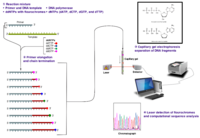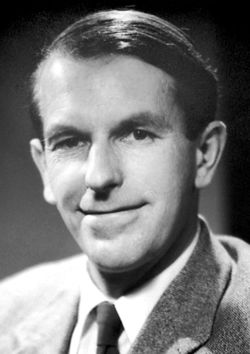Frederick Sanger
Frederick Sanger was a British biochemist, born on August 13, 1918 in Rendcombe in Gloucestershireand, England. [1] Sanger received his education at Bryanston School and at St. John's College Cambridge. While attending in 1939, he received his bachelors degree in the field of natural sciences. Frederick Sanger received his first nobel prize in Chemistry for his discovery of how insulin is formed from linked amino acids in 1958. He also won another nobel prize in 1980 for inventing a method of reading the genetic code made up of molecular letters. This was a crucial development in his field of biochemistry that lead to the decoding of the human genome. Eventually in 1977, Sanger decoded an entire genome of a virus consisting of more than five thousand letters. [2] Dr. Sanger retired three years after he won his second Nobel prize. [3] Frederick Sanger's career ultimately ended when he died on November 19, 2013 in Cambridge at the age of 95. [4]
Early Years and Education
Frederick Sanger was born on August 13, 1918 in a little town in Gloucestershire, England. Sanger was the second son of Frederick Sanger and his wife Cicely Sanger. His family was reasonably wealthy. Dr. Sanger had two siblings, Theodore and Mary.[1] He was raised as a Quaker and because of this Quaker upbringing, he was excused from fighting in World War I. [5] However, later in his life he became an agnostic because he claimed there was a lack of evidence to support it. [2] At the age of fourteen, Sanger went to Bryanston School, where he enjoyed scientific and mathematic subjects. Sanger took his School Certificate a year early and gained seven credits for it. This was one of the highest marks of one of Bryanston's students ever reached. His achievements of this caliber granted him a direct entry into Cambridge. [6]
Initially Frederick Sanger started at a university to study medicine, but later changed his mind after studying biochemistry at Cambridge. Sanger had reasons for switching what he studied especially after he saw how hard his father worked as a doctor. Sanger said, "I felt I would be much more interested in and much better at something where I could really work on a problem". [2] He then decided to study insulin. While studying insulin he discovered how insulin was formed and continued studying it for the next ten years. [2]
Scientific Research
Frederick Sanger was the first scientist to decode the structure of the protein, insulin. Sanger's chose to work with the protein insulin because it was readily available in its purified form in large quantities.[7] While Sangers worked on determining the pattern of proteins, other scientists watched in doubt, saying the sequences of the amino acids was completely random. However, Sanger proved their thoughts wrong. [7] The structure of insulin appeared to be relatively simple but it took Sanger about ten years to completely decode its chemical sequence. His method used to analyze the bonds of insulin involved the process of breaking the protein into smaller and more manageable pieces. Then, he was able to show that insulin consisted of two polypeptide chains made up of two or more amino acids linked by disulphide bonds. All his research allowed Sanger to finally identify that insulin was made up of 51 amino acids. This technique helped other scientists determine sequences of other unknown proteins. [2] It was after his significant work on insulin, Frederick Sanger was awarded his first Nobel prize in 1958. [7]

Another important part of Frederick Sanger's scientific career is his work involving the sequencing of DNA. Sanger viewed the unknown order of DNA bases as a challenge, and took on the chance to determine their order. The challenge was attempting to determine the order of the four bases of DNA, adenine, thymine, guanine, and cytosine. Over the course of the nest fifteen years, Sanger and his team expanded on his previous work on proteins to develop one for DNA and RNA. Sanger persisted decoding DNA sequences even when at one point he said, "For a while I didn't see any hope of doing it, though I knew it was an important problem". [2] His new approach, allowed him to be able to read stretches of DNA consisting of 500-800 letters at a time. This method is now called the Sanger method. Sanger and his team developed the complete method in 1977, and it was capable of reading genomes that could stretch out to as much as 3,000,000,000 base-pairs long at 500 bases at a time. [7] This new method was used extensively in, and made the Human Genome Project possible. [5] The Sanger method allowed scientists to determine sequences of long chains of DNA that would have taken years, in a short amount of time. [5]
Honors and Awards
Frederick Sanger is one of the few people to win two Nobel prizes. The only other people to win two Nobel prizes were Marie Curie, Linus Pauling and John Bardeen. [5] His first nobel prize was won in 1958 for discovering how amino acids linked together to form proteins like insulin, and his second Nobel prize was won in 1980 for developing a method to read molecular letters in the genetic code. [2] He was the only person to win two nobel prizes for chemistry as of 2105. The Wellcome Trust Sanger Institute is named in Frederick Sanger's honor. He was awarded the Corday-Morgan Medal and the Prize of the Chemical Society in 1951. He became a Fellow of the Royal Society and a Fellow of King's College, Cambridge in 1954. [1]
Later Years
Frederick Sanger retired when he felt he had reached the climax of his career at the age of 65 in 1983. He felt the need to take a step back from the scientific realm to leave room for younger scientists to thrive. He spent most of his time outside of his scientific work, in his garden. [8] The Wellcome Trust and the Medical Research Council founded the Sanger Institute named after Frederick Sanger himself in 1992. Sanger also turned down a knighthood in his later years because he did not like the idea of having to be addressed as "sir". [5] Frederick shares his opinion on knighthoods, "A knighthood makes you different, doesn’t it, and I don’t want to be different". [7]
Quotes
| “ | It is like a voyage of discovery into unknown lands, seeking not for new territory but for new knowledge. It should appeal to those with a good sense of adventure. [9] | ” |
| “ | Scientific research is one of the most exciting and rewarding of occupations. [9] | ” |
| “ | Through art and science in their broadest senses it is possible to make a permanent contribution towards the improvement and enrichment of human life and it is these pursuits that we students are engaged in.[9] | ” |
| “ | When I was young my Father used to tell me that the two most worthwhile pursuits in life were the pursuit of truth and of beauty and I believe that Alfred Nobel must have felt much the same when he gave these prizes for literature and the sciences.[9] | ” |
Videos
A brief video biography of Frederick Sanger
An interview with Frederick Sanger on August 24, 2007
References
- ↑ 1.0 1.1 1.2 Frederick Sanger - Biographical NobelPrize.org. Web. Date of last access May 5 2016 Unknown Author.
- ↑ 2.0 2.1 2.2 2.3 2.4 2.5 2.6 Gellene, Denise. Frederick Sanger, 95, Twice a Nobel Laureate and a Genetics Pioneer, Dies The New York Times. Web. Dateofpublication Nov. 20 2013.
- ↑ Biography.com Editors. Frederick Sanger Biography. Web. Date of last access May 8, 2016.
- ↑ . Frederick Sanger - Facts NobelPrize.org. Web. Date of last access May 5 2016 Unknown Author.
- ↑ 5.0 5.1 5.2 5.3 5.4 Lorch, Mark. Frederick Sanger’s achievements cannot be overstated The Conversation. Web. Dateofpublication November 21, 2013.
- ↑ Sanger's early life: From the cradle to the laboratory WhatIsBiotechnology. Web. Date of last access May 8 2016 Author Unknown.
- ↑ 7.0 7.1 7.2 7.3 7.4 Frederick Sanger, OM The Telegraph. Web. Date of publication Nov 20 2013 Unknown Author.
- ↑ A gene is a discrete sequence of DNA nucleotides. DNA from the Beginning. Web. Date of last access May 8 2016 Unknown Author.
- ↑ 9.0 9.1 9.2 9.3 Frederick Sanger Quotes BrainyQuote. Web. Last Accessed May 2 2016 Author Unknown.


